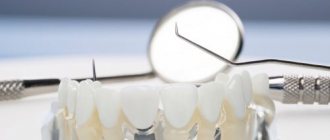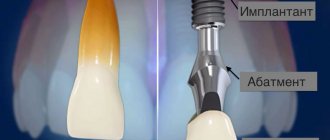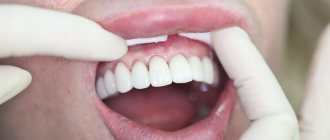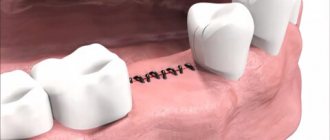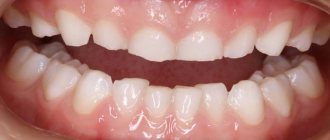- home
- Dental news
- Teeth filing
|
|
A unique teeth filing procedure has been used to create a perfect smile since 200 years ago. At that time, such a unique treatment was used to prevent caries by completely removing damaged hard tissues. Now the technology is actively used in dentistry to eliminate aesthetic defects and straighten teeth.
Filing is recommended for patients whose one or more teeth differ in size or stand out from the general row. A popular indication for the procedure is the presence of small chips on the fangs or incisors.
Fang extensions - why do people go for it and is the risk justified?
Young people are trying to “keep up with fashion.”
To achieve their goals, young people sometimes neglect the safety of their health. They strive to stand out from the crowd and be modern. Informal teenagers, especially those who consider themselves goths, try to follow fashion and grow fangs. This can be done with the help of modern dentistry. This desire arises, in most cases, in adolescents aged 14–20 years. It is rare to meet an older person who strives to grow fangs. Currently, tooth enlargement occurs using several methods.
Symptoms of tooth impaction
In most cases, an impacted tooth is detected on an x-ray at the dentist or at an appointment with an ENT doctor. Retention in a child can be determined if one of the elements of the jaw row is absent for a long time or if a baby tooth is not replaced by a permanent “brother” for too long. The eruption of an impacted tooth is usually accompanied by inflammatory processes. The child may be bothered by swelling of the gum tissue and jaw, pain and aches, numbness and tingling in the retention zone.
On palpation of the gums, thickening and hardening are noted, reminiscent in shape and outline of an unerupted tooth.
What could be the motivation?
Fangs can be extended or restored for dental reasons or for beauty.
For medical purposes, canine extensions are necessary for the following purposes:
- the enamel is damaged or has microcracks;
- the tooth has damage from deep caries or the hard tissue has suffered mechanical damage;
- the tooth wears out with age;
- for defects that cannot be corrected aesthetically;
- There is pronounced pigmentation on the enamel.
In order to improve (change) their appearance, each person makes an independent decision about the advisability of growing fangs.
Over the past few years, this procedure has only gained popularity. Patients are confident that restoration of certain teeth can correct their facial expression and make their smile more mysterious and unusual. They are confident that they will acquire a certain charm and novelty.
In most cases, manipulations on the fangs are performed only for decorative aesthetics.
Indications for nerve removal
- Caries has reached the pulp. Initially, caries appears on the enamel, then moves to dentin, then to the pulp. Inflammation increases: acute pain occurs. To eliminate the pain and save the tooth, you need to remove the nerve.
- Injuries of various types: impact, fracture, chip. With such mechanical impact, traumatic pulpitis develops. The integrity of the tooth is damaged, the infection penetrates into the pulp. Inflammation occurs and pain appears. Treatment involves removing the nerve.
- Retrograde infection. When inflammation occurs at the apex of the tooth root, it then spreads to the nerve.
- Orthopedic treatment. Before placing a crown, in some clinical cases it is necessary to remove the nerves. To avoid complications, a severely damaged tooth is first treated: the nerves are removed.
- Asymptomatic pulpitis (chronic). The patient does not have acute pain, but the nerve is infected. The patient's complaints may include mild pain in the past.
Contraindications
Restrictions that future “vampires” should take into account:
- work will not be carried out with periodontitis;
- The patient will also receive a refusal if the bite is incorrect, if the load when eating food is not distributed evenly;
- extension is impossible if the canine is severely damaged, in this case a crown is put on;
- with irregular oral care;
- if you are allergic to the material used;
- deep caries;
- If the enamel wears out too much, extensions will be ineffective.
My comment on this treatment:
I am satisfied with the result of the treatment and, probably, with the entire treatment process (even the slight anxiety and scrupulousness of the patient), it is nice to see in the end a satisfied, grateful and constantly laughing patient.
What does modern dentistry offer?
When growing teeth, in particular fangs, depending on the situation, three methods are used.
Direct method
The growth occurs in the oral cavity.
Various materials are used for dental reconstruction. The material is applied in layers to the prepared tooth. The thickness is selected based on the patient’s wishes. After the procedure is completed, the hardened material is polished and brought to perfection.
The procedure takes a minimal amount of time, no more than one hour per tooth. When growing two fangs, the time spent will be about one and a half hours. The work will be carried out sequentially, which will save time.
Installation of veneers and other overlays
The main work takes place in the dental laboratory.
Veneers are very thin plates made of dental material that resemble enamel in properties. Tooth surface
prepared, after which the plates are glued to a special solution.
Instead of veneers, you can install lumineers. They are similar to tooth enamel, and thanks to a special production technology, their thickness is reduced to 0.3 mm.
Such plates are classified as aesthetic dentistry. With their help you can hide imperfections in your teeth. Masks chips, cracks and stains on tooth enamel.
Installation of crowns
Crowns are selected according to the required size and shape, which is determined by the orthopedic dentist. The production is carried out by a dental technician.
When choosing a crown, you can choose the material from which future fangs will be made. There are also several ways to install the finished product.
The most popular crowns:
- Metal-ceramic . A thin layer of ceramic is applied to the metal, which allows the tooth to look more natural.
- Ceramic . They are made from zirconium dioxide and have the same characteristics as metal.
You can install a crown:
- on your treated tooth;
- if the tooth root is preserved, then it can be installed on a stump tab;
- you can mount the pin and put it on it.
Read also: How to soothe pain
You can grow fangs by no more than 4 mm using a crown. With a more massive build-up, the oral mucosa and tongue will be injured. Permanent injuries can lead to disastrous results, including the formation of a tumor.
Do you want beautiful dental restoration?
8
or order a free call
Request a call
How the shades of cement were selected during fixation
The work on dental restoration was varied, and we worked with both crowns and dental modules:
- the upper anterior teeth, which were restored using “crown + tooth root” modules, were fixed with double-curing cement,
- and those teeth on which I placed veneers and crowns were fixed with light-curing cement so that in bright daylight the glue would not be noticeable
Light reflecting off the crown or veneers can make the luting cement visible. In addition, due to the fact that the working surfaces of the teeth were of a non-uniform color, with the presence of a yellow tint, it was necessary to work with different colors of cement. That is, I used more yellow cement where the roots of the teeth were and used light-neutral-colored cement on the veneers and crowns to achieve a uniform color scheme. It's very difficult to get the color perfect
.
But we managed to do
:
Naturally, Aryuna is now the most super beautiful:
Aryuna, as I said earlier, works on television, she is a fairly public person - she interviews TV and show business stars. She appears on camera very often, and for her such a smile is not only a guarantee of her good mood, but also great confidence in herself and her abilities. After all, an open and cool smile is the key to female success
! This job, according to her, is the ideal solution for her. Made your smile easy, quick and beautiful!
Aryuna left a video review, short but very charming
:
And in conclusion of my story about this case of restoration of the front teeth, let’s once again go through all the stages
of transforming Aryuna’s smile:
- Photo BEFORE the start of
dental restoration. Aryuna came to me with such a smile; she has old temporary structures. - View of temporary structures on the 6 anterior teeth of the upper jaw.
- Temporary structures were removed and teeth and tooth roots were prepared for prosthetics.
- Selecting the color of the veneers.
- New temporary structures were installed. Your smile transformation has begun!
- Aryuna's smile with new temporary structures.
- In the meantime, we prepared the permanent teeth. This is how they “sit” on the model.
- And this is what all the elements of the teeth that we will install for our patient look like
- The teeth have been installed. Close-up - looks great!
- View of a smile on the right
- View of a smile from the left
- FINISH!
ARYUNA'S SMILE WITH NEW TEETH!
Author:
Sergey Samsakov
orthopedic dentist
born 02/02/1989
Education:
2011 — Graduated from the Moscow State Medical and Dental University named after. A.I.Evdokimova
2012 — Internship in the specialty “Orthopedic Dentistry”, Moscow State Medical University named after. A.I.Evdokimova
2014 - Residency in Orthopedic Dentistry, Moscow State Medical University named after. A.I.Evdokimova
Weighing the Pros and Cons
In most cases, canine extensions are an aesthetic need. Only in rare cases is such a procedure necessary for medical reasons and it is carried out using artificial material. In many cases, it is simply necessary to restore the appearance of the tooth.
Vampire fangs are a tribute to fashion; they are common in some subcultures among young people.
What does reconstruction give:
- aesthetic indicators increase, the smile becomes natural, snow-white and beautiful;
- durability of materials;
- the ability to completely restore a tooth, even if some part is missing, the main requirement is the presence of a healthy root and the presence of bone tissue in the required volume;
- you can change your smile, appearance and image.
- high cost of the procedure;
- there is no one hundred percent guarantee for a long-term result; the fang can break due to improper care or when chewing hard food;
- The procedure cannot be carried out if the root is slightly damaged.
What do extended fangs look like for girls and guys in real life:
Long-term consequences after treatment
Patients often experience complications after nerve removal. This is due to many factors: lack of diagnosis, poor quality treatment, incorrect diagnosis, etc. Main consequences:
- poor canal filling. A loose filling leads to the re-emergence of bacteria that extend beyond the tooth root. A cyst forms, due to which the tooth is often removed;
- tool fragments. The complex anatomy of the canals and low-quality instruments can lead to its failure.
- removal of material beyond the root apex. If the filling material is chosen incorrectly or there is too much of it, it extends beyond the root.
- Tooth perforation occurs due to aggressive processing.
To avoid such complications, doctors at the SDent clinic recommend contacting us for medical help, as we have a staff of highly qualified doctors, an equipped X-ray room and advanced equipment!
Features of care
To increase the service life of artificial fangs, they must be properly cared for.
Care instructions:
- Do not use cleaning products with abrasive particles;
- A toothbrush should be used with soft or medium hardness;
- smoking and large amounts of coffee can damage dental material;
- You need to brush your teeth at least twice a day;
- To increase the service life of the products, you should visit the dentist twice a year and conduct a preventive examination; if necessary, the doctor will polish the fangs and cover them with a protective varnish.
It is impossible to grow fangs professionally at home. To increase the size or restore a tooth, special dental materials are required. You will also need equipment to harden the drug.
But at home you can make temporary vampire teeth from scrap materials.
General recommendations after treatment
- You can eat and drink immediately after treatment;
- Until the anesthesia wears off, you should not eat rough food;
- in the days following treatment on the side of the diseased tooth, do not chew rough, hard food;
- in some cases, anti-inflammatory drugs, painkillers, and oral baths are prescribed;
- If a temporary filling falls out, consult a doctor immediately;
- If pain occurs after placing a temporary filling, also consult a doctor immediately.
After the anesthesia wears off, the patient may feel discomfort in the area of the treated tooth. If pain, throbbing, or swelling occurs, you should consult a dentist.
Cost of the procedure
The cost of the extension procedure depends on several factors:
- complexity of the chosen method;
- cost of the material used;
- the prestige of the clinic;
- specialist qualifications.
The price range is between 4-40 thousand rubles per tooth. Cosmetic restoration will cost around 5 thousand rubles. If preliminary treatment of caries or other additional dental services is necessary, the cost will increase.
Installing crowns will cost more, but the cost will directly depend on the material chosen. Simple metal ceramics will cost 4 thousand rubles, and a completely ceramic tooth will cost no less than 20 thousand.
The most expensive material for fang extensions is veneer. Its cost will be from 25 thousand per tooth.
Before you decide to take such a serious step, you should think everything over carefully and weigh the pros and cons. You can make an outwardly beautiful shell, but harm your health. The decision to enlarge fangs is strictly individual; there cannot be one opinion.
Why do you need to grow fangs?
The main task of the dentist is to recreate damaged tissues, replace lost teeth and restore their structure using onlays made of composite materials or prosthetics. After dental surgery, your smile should look as natural as possible. Anterior teeth augmentation is indicated in the following cases:
- presence of chips and cracks;
- cracks and damage to enamel;
- congenital weakness of tooth enamel;
- wear of the enamel due to age-related changes;
- curvature of teeth and their irregular growth;
- pathological bite;
- traumatic injury;
- generalized caries;
- the formation of spots and defects of various sizes, shapes and colors on the enamel surface.
Read also: Toothache at night
Types of location of an impacted tooth
| Fine | The tooth has a vertical position and grows upward very slowly. Baby teeth and canines can grow properly. “Wisdom teeth” are rarely positioned normally. |
| Horizontally | The impacted tooth forms a right angle to the healthy one, located horizontally. This situation is detrimental to a healthy “neighbor”. In such a situation, it is necessary to remove the impacted tooth, which is performed only surgically. |
| Obliquely | An impacted tooth grows at an angle toward the cheek or tongue. If such an anomaly does not cause inconvenience to a person, then removal is not necessary. |
Contraindications
List of restrictions to the procedure:
- inflammation of the gum tissue;
- the upper incisors significantly cover the lower ones;
- direct bite, which causes abrasion of the chewing surfaces of the lateral and cutting edges of the front teeth;
- chronic inflammatory disease of the pulp;
- absence of molars, which leads to uneven distribution of chewing load;
- bruxism;
- hypersensitivity to composite materials and dentin adhesives;
- deep subgingival destruction of the root part of the canine;
- tooth destruction by more than 30%;
- metal and metal-ceramic crowns on antagonist teeth;
- the patient has a pacemaker;
- extension cannot be done on milk and permanent teeth, in which the processes of root formation and tissue mineralization are not completed.
Causes of increased tooth wear
- The need to correct the bite: if, for example, the teeth “overlap” each other, or the upper teeth overlap the lower ones;
- general organic diseases: gastric ulcer, renal dysfunction, chronic alcoholism, vomiting during pregnancy, anorexia, esophagitis, etc.;
- unbalanced diet and consumption of unhealthy foods: excess food intake of citrus fruits and/or freshly squeezed juices, wine, spicy and pickled foods, herbal teas and carbonated drinks;
- hazardous work factor: this risk group includes employees of enterprises producing acids and other caustic chemical substances;
- factor of bad habits: frequent consumption of seeds, frequent use of a special brush to clean interdental spaces, habit of biting off floss with teeth;
- violation of teeth brushing technique and improper oral hygiene: addiction to abrasive and whitening pastes, excessive pressure on the teeth with a toothbrush and floss;
- Unsuccessful dental prosthetics: poorly made dentures provoke excessive pressure on the teeth or cause them to constantly come into contact with metal elements;
- Bruxism: This is the name given to involuntary grinding of teeth while sleeping.
Extension methods
When choosing a method of extension, the dentist takes into account the degree of destruction of the canine and the patient’s wishes regarding the cost of medical services. Modern orthopedic dentistry offers several options:
- microprosthetics using ceramic inlays (from 10 to 15 thousand rubles);
- installation of veneers and lumineers (from 20 to 30 thousand rubles);
- artificial crown (from 5 to 10 thousand rubles);
- implantation (from 70 to 120 thousand rubles).
The extension is done directly in the oral cavity. Dental therapists have photopolymers (light-curing filling materials) in their arsenal. The material is applied to the prepared tooth in layers. The thickness is selected based on the anatomy of the dental system. The hardened material is ground and polished. The duration of the procedure is no more than one hour per extended tooth. Fangs grow in one and a half to two hours.
Restoration with installation of veneers
Veneers are porcelain or composite plates that replace the vestibular layer of teeth. Lumineers, or ceramic veneers, are much thinner and are fixed without grinding down the fangs. Using plates that are indistinguishable from real tooth enamel, you can mask aesthetic defects, microcracks and hide uneven tooth coloring. Artificial teeth made from veneers will last no more than ten years.
Installation of an artificial crown
If the canine is severely damaged, the patient is offered to undergo extensions using crowns, which restore the anatomical shape of the tooth. If there is no history of hypersensitivity to metals, classic metal-ceramic crowns are used. An alternative to them are crowns made of ceramics and zirconium oxide.
The restoration is carried out in stages: first, the dentist prepares the surface of the tooth, grinding and eliminating the affected areas on the outer walls; At the second stage, an impression, or impression, of the tooth is taken. Metal-ceramic crowns are one and a half times cheaper than artificial ones.
How is turning for veneers carried out?
The reliability of the installation of microprostheses depends on the quality of preparation of the dental surface. Traditionally, the stage of grinding teeth before veneers proceeds as follows. First, the doctor determines the thickness of the enamel layer on the vestibular surface of the teeth that will need to be removed. Next, the dentist makes grooves with a special tool and, focusing on them, grinds down the required amount of dental tissue. In this case, near the gum, the preparation is performed in the form of a grooved ledge. Then the doctor moves on to treating the side surfaces. It can be carried out in two ways: by maintaining the contact points between the teeth or by slightly “grabbing” their lingual surface. The first option is good for preserving the integrity of the dentition, the second has a positive effect on the appearance of future veneers. As for the incisal edge of the teeth, the need for grinding it is directly related to the model of the veneer and the technical requirements for its installation.
Make an appointment
right now!
Mikhailov Andrey Vladimirovich
Surgeon, Orthopedist, Implantologist
Stages of the procedure
Artistic restoration of fangs is not complete without a complex of preparatory therapy and preventive measures.
Preparation can be divided into 2 types of procedures – general preparatory and direct mandatory. The first are carried out at the request of the patient and if there are indications, and the second represent a preliminary part of the restoration of tooth tissue. The dentist pays attention to the condition of the oral cavity, dental tissue and gums. Professional scaling, plaque removal, and cavity treatment may be necessary before fangs can be made. Then an impression of the future canine is made. Using an impression, the appropriate shape and size are determined.
An important stage in growing fangs is preparation. This procedure, which involves removing (grinding) the surface dental tissues, is necessary for high-quality adhesion of the composite to natural tissue. Preparation requires extreme caution: the doctor must sharpen the structure so as not to injure the deep layers of bone tissue.
The listed methods have obvious advantages over implantation and prosthetics. Extension is actively practiced in pediatric dentistry.
Read also: What is the doctor’s name for dental prosthetics?
Sequence of treatment
- Diagnostics . After the doctor has examined you and collected your medical history, an X-ray is taken. This diagnosis allows you to evaluate the structure of the tooth and plan treatment. To see the full anatomy of the root canals, a computed tomography (CT) scan is performed - a 3D diagnostic that allows you to see all the structures of the tooth.
- Pain relief . Local infiltration or conduction anesthesia is performed. Before the injection, the gums are lubricated with an anesthetic gel so that the injection is not felt.
- Setting up insulation . Root canal work should be done in clean, dry conditions. For this purpose, rubber dam (insulation) is used. It is a latex plate that is placed on the tooth. Advantages of isolation: saliva and plaque do not enter the root canals. Medicines and solutions also do not flow into the patient’s mouth.
- Preparation of hard dental tissues . The doctor uses a drill to remove the destroyed tissue. To prevent overheating of the tooth, water flows from the tip. The doctor creates direct access to the root canals.
- Nerve removal . It is performed with thin sterile instruments similar to long needles. The doctor places an instrument into the root canal and removes the nerve. Machine rotary tools may also be used. This stage is completely painless, since anesthesia was previously performed.
- Mechanical and medicinal treatment of canals . The canals are washed with special antiseptic solutions and passed through with instruments. This allows you to completely remove the diseased nerve and relieve inflammation.
- Temporary filling . Root canal work is complex, so it is not always possible to treat a tooth in one visit. An anti-inflammatory paste is placed into the canals, a temporary filling is placed, and a further stage of treatment is planned.
For permanent restoration of the crown part of the tooth, ]esthetic dentistry[/anchor] will be required.
Is it possible to grow fangs at home?
To restore the mineral composition of the tooth and the density of damaged enamel, special compounds with calcium and fluoride are applied. This process is called remineralization.
Options for applying remineralizing compounds:
- applications using wax matrices, trays and gels;
- brushing with Japanese toothpastes;
- professional remineralization in the dentist’s office;
- use of fluoride-containing drugs.
The last two methods cannot be repeated at home. Remineralization in dental clinics is not only the replenishment of missing minerals, but also the prevention of caries.
I'm not a fan of the vampire subculture, but I've long dreamed of slightly lengthening my fangs. I want to find an experienced dentist who will do it carefully and efficiently, and I won’t look like the wife of Count Dracula
I never understood why fangs should be lengthened without indication. My tooth was broken, the dentist restored it with veneers. He did it so well that you couldn’t tell by looking that the tooth was partially artificial.
How was the restoration of the front teeth carried out?
So, Aryuna had problem 4 front teeth; crowns and missing modules needed to be made on them:
- two missing modules with tooth roots,
- two crowns.
And we also decided to use the two upper canines
— put two Luxury veneers on them to make Aryuna’s smile more complete. Why did you decide to use fangs? – The canines had to be included in the group for restoring the aesthetics of a smile, because the 4 restored teeth will eventually, after 5 years, be noticeable in color - their own teeth will darken, but the veneers will not.
We ended up working with six teeth
.
Stages of smile restoration:
My first task
temporary crowns were removed and four teeth were prepared: two for a crown and two for monolithic crown + tooth root structures:
Second task
I had to minimally prepare the two upper canines for veneers, which I did.
I treated the fangs with micro-grinding. I also made six temporary structures in the first appointment. smile
immediately :
We removed the old temporary crowns, ground the teeth and made new temporary orthopedic structures, and after 4 days we received laboratory veneers: the color of the neck is 1M2, and the body of the tooth is 1M1:
At the second appointment, I removed the temporary structures, installed all six new teeth for fitting, and the patient really liked everything. And after that I recorded them permanently.
Sergey Samsakov



